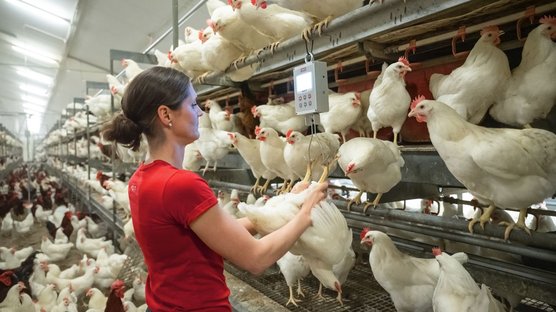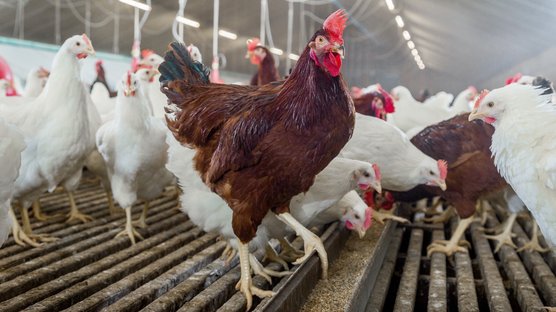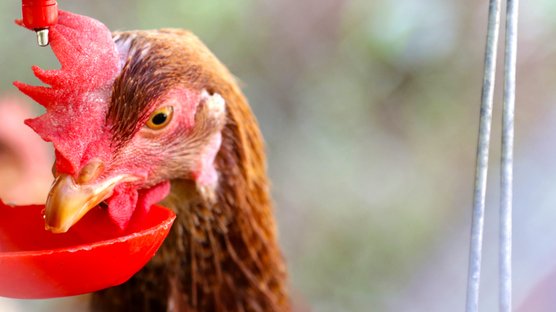
Published on April 23, 2021
Feed Capacity Development
Modern laying hens have the potential to generate more income than ever to egg producers as a result of decades of sustainable breeding, as today’s hens can reach higher peaks of production and have drastically improved laying persistency.
Combined with improved egg weight curves, better livability and longer lasting feather cover, these factors have resulted in longer production cycles. Additionally, the age of transfer and the start of the laying cycle now come earlier and faster, as shown in Figures 1a and 1b.
Figure 1a: evolution of laying rate and egg weight in white laying hens
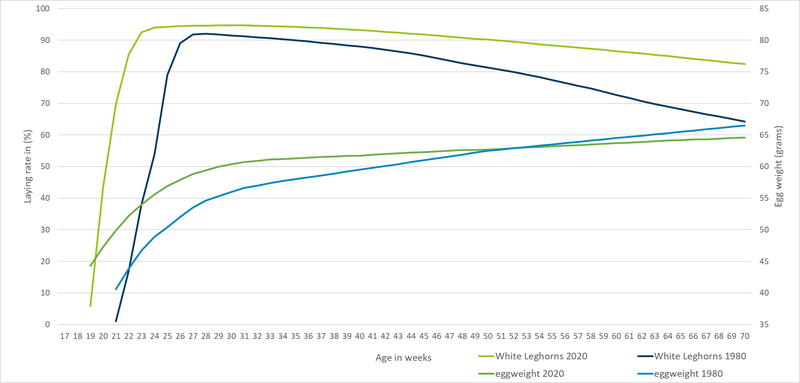
Figure 1b: evolution of laying rate and egg weight in brown laying hens
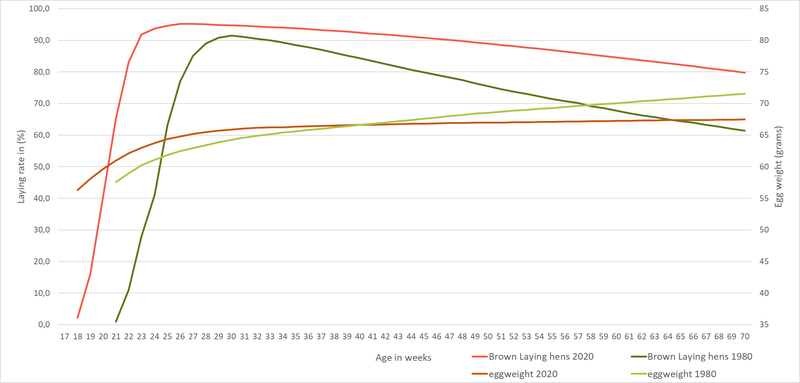
However, in order to achieve the full genetic potential of your birds, it’s more important than ever to have a well-balanced feeding strategy, which is why this article will provide insight into the key factors that we recommend for a well-balanced feeding strategy during the rearing period.
The importance of the rearing period
Obviously, the first 18 weeks of the lifetime of a bird have a massive impact on production results later in the birds’ life. At the onset of laying, there is an increase in a birds’ growth and maintenance cost as well as a fast increase in the daily laying percentage, which results in an also fast increase of essential nutrient requirements. If birds’ feed intake is not high enough or the feed composition is limiting, there is a good chance that the birds will have a nutrient deficiency, which will have an impact on the birds’ performance later during their productive lifetime.
In order to maintain good egg laying persistency up to 100 weeks of age, it is essential to take good care of your birds during rearing and to make sure they are well prepared when they arrive at their production houses. After the onset of laying, it is much more difficult to make corrections than during the rearing period. Unfortunately, even with todays’ knowledge, the importance of rearing is not always acknowledged in the field.
One potential consequence of neglecting the importance of the rearing period is inability to reach target body weights at key phases. The body weight profile during rearing is especially important; body weight development at 5 weeks of age, as well as bodyweight at time of transfer to the production house, are key indicators during the rearing period that have impact on the birds’ performance later.
This is clearly demonstrated by the high correlation between egg weight and a bird’s development during rearing. The better the body weight development during rearing (e.g. a good body frame), the bigger the egg size from the start of production onwards (and vice versa). Moreover, body weight at the end of rearing has a high correlation with laying persistency towards the end of the production period.
One important aspect of rearing is the uniformity of your pullets, which can either be maintained or lost during rearing. Ideally, uniformity should be over 85% for brown birds and 90% for white birds. This will help to maintain the peak of production for a longer period of time and will boost production later in life, as overall nutrient requirements of birds within a flock will be more similar, allowing you to better meet their needs.
Also, a proper feed intake capacity and a well-developed gastrointestinal tract will help the birds during production. For example, it has been shown that higher density diets often result in lower intestinal weight and a relatively heavier fat pad during rearing. Unfortunately, this heavier fat pad does not prevent a shortage of nutrients at laying onset, and it can even increase the incidence of prolapse.
However, pullet quality isn’t the only factor that influences laying hen performance; other factors like health condition or immunological competence also play a role.
Feeding management
In addition to the composition of the feed, feeding techniques will affect development of birds’ feed intake capacity and daily nutrient intake. By nature, birds are grain eaters; they will therefore select mostly for coarser particles while leaving the finer particles, which can cause fine particles to start to accumulate in the feeding system. This will also result in a disbalance of the daily nutrient intake, as those finer particles contain a higher concentration of amino acids, fine calcium, and premix.
This means it is absolutely essential to empty the feeders once a week until 5 weeks of age, and once a day for 1 to 1.5 hours from 5 weeks of age onwards. Birds need to have energy and protein for the production of egg yolk and egg white in the morning, and calcium in the afternoon. Thus, they consume more feed in the morning and afternoon. When birds are in production, 60% of the total diet should be fed in the last 6 hours of the day.
To train and prepare the birds already during the rearing period for optimal feeding management during the production period it is advised to feed the majority of the diet in the afternoon. To encourage feed consumption and meal feeding, we recommend that 60% of the daily ration should be given about 2 to 3 hours before “lights off”. At “lights on” the birds will eat finer particles, because their digestive systems are empty. If the feeding system does not allow the entire daily ration to be given in one single distribution, it is possible to implement block feeding. Block feeding is a method to have two feed runs short after each other. It can be a tool to improve the uniformity of the flock, especially when there is competition for the amount of feed places available at the feeders. In this case the more dominant birds can digest their meal, while the less dominant birds also have the opportunity to consume new and fresh feed that still contains all essential nutrients. Please do keep in mind that it is important to empty the feeders once a day, as this helps to prevent selective eating and will increase the general uniformity of the flock.
Quite often it is observed that the number of feed distributions is increased when feed intake problems are faced. However, this has a detrimental effect on the flocks’ uniformity due to selective eating. The advice is therefore to empty the feeders in the middle of the day.
In order to maintain flock uniformity, it is important to have enough living, feeder, and drinker space. But even when you have enough feeder and drinker space, water quality can still affect feed intake; if birds do not drink water, they also won’t eat. Regularly check the water quality of the water provided to the birds. Water quality is often forgotten, but it is one of the most important factors for good pullet development. Related to this, try to prevent any occurrence of water pools in the range. It is well known that the birds that range have a strong preference to drink from these mud pools, whilst it is in general the worst quality water that your birds could drink.
Figure 2a: white laying hens, egg size in relation to bodyweight

source: Schothorst Feed Research 2020 (unpublished)
Figure 2b: brown laying hens, egg size in relation to bodyweight

source: Hendrix Genetics Internal data
Starter phase
It is highly recommended to start the starter phase starts with proper early feeding; early feeding is applied to stimulate the absorption of the yolk residue, which reduces the risk for a yolk sac infection. If young chicks have no access to early feed, they will lose around 0.3% of their body weight per hour.
Proper feed intake can be checked via crop filling. Ten hours after placement, 80% of the chicks should have a filled crop, which should go up to 95% twenty-four hours after placement.
Feed intake is still limited during the first 5 weeks of the chick’s lifetime, due to the limited capacity of the gastrointestinal tract. At this stage, birds are still not able to regulate their energy intake according to the energy level of the feed. In addition, chicks are born poikilothermic and take around 4-5 days before to become homeothermic. Keeping the brooding house at the proper temperature is of key importance during the first week after arrival, as it will prevent chicks laying down without eating or drinking (also known as “non-starters”).
During the starter period, the focus is on organ development, as shown in figure 3. Therefore, it is necessary to provide a highly concentrated high-quality feed that meets a chick’s daily nutrient requirements. Providing a crumble encourages feed intake and therefore growth. With a crumble, the nutrient intake will also be more homogenous, which will also better meet daily requirements.
Figure 3: body weight development during rearing and start of lay

Grower phase
If the body weight is up to the desired standard, feed composition switches from a starter feed towards a grower feed. Grower feed has a lower energy level than starter feed in order to stimulate the chicks’ feed intake. As chicks increase their feed intake, the protein level can be slightly reduced; this will encourage the maximum growth of the chicks in the period of 6 to 11 weeks of age.
If mash diets will be given to the birds during the production period, this is the period when feed structure needs to be changed. Preferably, mash should contain a maximum of 10% fine (below 0.5 mm) particles and 10% coarse (over 3.2 mm) particles. More coarse particles can increase selective eating, while more fine particles can result in longer eating time, which will both result in reduced feed intake and consequently reduced development and reduced flock uniformity.
A coarser diet will stimulate the development of the gastrointestinal tract. To stimulate gizzard development, it is recommended to provide grit: 3 grams per week, with a particle size of 2 to 3 mm.
Developer phase
This is the period to train your birds to eat and to further stimulate the development of the gastrointestinal tract. By this time, most of the skeleton and the body frame has already been developed. Therefore, a high increase in body weight during this period often results in an increase in fat deposition instead of an increase in frame size.
A second reduction in the energy and protein content of the feed will increase the birds’ feed intake without developing a fat pullet. It is easier to reach this by increasing the fibre content of the feed. Also, coarse insoluble fibre will also stimulate the development of the crop and will increase the birds’ eating time. Proper feed particle size with additional grit (4 to 5 gram per week, with 3 to 5 mm in particle size) will help stimulate the development of the gizzard.
Pre-peak phase
Whether or not a pre-peak diet is being used, feed intake from the end of rearing until the peak of production should increase by 50%, while body weight should increase by 30%. Part of the increase in body weight can be explained by development of the reproductive organs, as shown in figure 2. This development of the reproductive organs also results in an increase in the birds’ water intake. As such, it’s important to ensure that fresh good quality water is available at all times during rearing.
There will be a short period of nutrient shortage at the onset of laying, meaning birds will consume less nutrients than they require at that moment, so it is ideal to keep this period as short as possible. Increasing the energy density from the developer phase into the pre-peak phase will help to shorten and flatten this period. It is advised to formulate for higher energy levels (+ 50-100 kcal per kg feed) in the production phase than the developer phase. Otherwise, the birds will need to consume even more feed, as the concentration is lower, to offset the higher requirement.
When feed composition is not adjusted accordingly, feed in the pre-peak period will be diluted automatically, since the level of calcium in the diet is increased for the formation of the eggshells. As calcium has a low added value for energy, this will automatically reduce the energy content of the feed. Because of this, it is extremely important to adjust the level and the type of energy rich components (such as oil) in the feed.
For the production phase, it is important to continue feeding the first phase until the moment that the daily egg mass being produced starts to go down. It is advised to monitor the performance of your birds carefully (at least weekly) so you can feed them according to their needs.
Why is development of the gastrointestinal tract so important?
Digestion mainly starts in the proventriculus, the glandular stomach, which (1) secretes hydrochloric acid to reduce pH and (2) adds digestive enzymes (as pepsinogen) to start the protein digestion. After the proventriculus, feed enters the gizzard (also known as “the mechanical stomach”). The thick mucosal layer of the gizzard together with the coarse particles and grit serves to function as a grinder.
Coarse particles have a longer retention time in the crop and gizzard, which therefore increases production and mixing with digestive acids. As a result, breakdown of nutrients prior to entering the small intestine is increased. Whereas small particles do not need to be ground, which will reduce retention time in the gizzard. This consequently reduces the mixing with digestive acids – which causes reduced nutrient digestibility and availability. This can result in a microbial disbalance, due to a higher level of undigested nutrients in the large intestine. This is to be avoided, as it can result in wet litter and a higher incidence of dirty eggs.
Decades of balanced breeding have resulted in birds with the genetic potential for higher production peaks and longer production cycles. However, in order to realize that genetic potential, egg producers need to have a well-balanced feeding strategy during the all-important rearing period in order to achieve that genetic potential.

